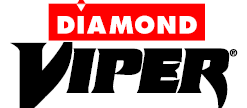Diamond Viper Radeon HD 3870 Showcase
Introduction

Throughout most of the 1990s, Diamond Multimedia was one of the major players in the graphics card world. Their well made cards with solid performance resulted in some of the most well known brand names of the time including the Speedstar, Stealth, and Viper. After merging with S3 Incorporated in 1999, the resounding failure of their joint contribution: the Diamond Viper II Z200 based on S3's Savage 2000, eventually led to the combined Diamond/S3 company backing away from third-party graphics cards.
In 2003, however, Best Data stepped in and purchased the rights to the brand name and assets from SONICblue Incorporated, including the Stealth and Viper brand names. Focusing on ATI's Radeons as their GPU of choice, the original line-up seemed to be focused mostly on the lower-end, more mainstream cards, including the Stealth S80 we took a look at in early 2003. The good news is, with some more time and resources under their belt, Diamond has completely revitalized the Viper name in both body and spirit. Once again, with high-end products at the core, Diamond is a force to be reckoned with in the market. Today, we've got two of their HD 3870's in the labs for comparison - one is mostly plain vanilla but the other is an overclocked version utilizing GDDR4 memory. Let's get a bit more acquainted with them, shall we?
![]()
Diamond Viper Radeon HD 3870s
Features & Specifications
| 666 million transistors on 55nm fabrication process
256bit 8-channel GDDR3/4 memory interface Ring Bus Memory Controller
Unified Superscalar Shader Architecture
Full support for Microsoft DirectX 10 / 10.1
Dynamic Geometry Acceleration
Anti-aliasing features
CrossFire Multi-GPU Technology
|
Texture filtering features
|
INCLUDED BUNDLES:
An odd thing about the cards we received is in regard to their associated bundles. Now, as you will see on the next page, the packaging and even the cards themselves are nearly identical. The driver CD and manual are also the same, which should be expected as the drivers are universal and there's only so many ways you can show someone how to install a PCI-Express card into their system.
What becomes odd, then, is the included cables and adapters. With the 1GB overclocked Viper, we found a collection of component and S-VIDEO out cables, as well as a power splitter for providing 6-pin power to the card. Two adapters, one for VGA and the other for HDMI complete the collection. On the other hand, with the 512MB version, there's a component video cable and the same adapters, but a CrossFire bridge replaced the S-Video cable and there's no power cable. We seriously doubt there is much cost saving in either direction, and there's nothing wrong, per se, with either bundle. We just like a little consistency now and then, and feel both cards should come with all of the pieces we found in the separate sets. The 1GB card especially should also include a CrossFire bridge at the very least.


Viper Radeon HD 3870 1GB Viper Radeon HD 3870 512MB







